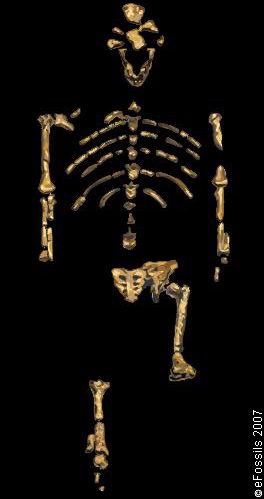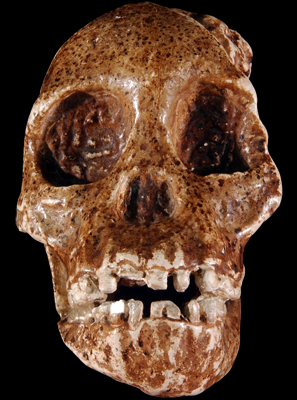the action of moving a skeletal element away from the midline of the body; opposite of adduction.
the action of moving a skeletal element away from the midline of the body; opposite of adduction.
a Lower Paleolithic tool culture first associated with Homo ergaster and Homo erectus; characterized by bifacially-flaked hand axes dating from around 1.5 million years ago to 150,000 years ago.
the process of adjusting to a particular environment or niche; a morphological or behavioral feature of an organism that evolved through natural selection to play a role or fulfill a particular function.
the action of moving a skeletal element toward the midline of the body.
a unit of hereditary information; an alternate form of a gene that sits at the same position on a chromosome.
the scientific study of humans, human culture, and the evolution of humans; subfields include archeology, cultural anthropology, linguistic anthropology, and physical anthropology.
under the superfamily Hominoidea, this includes gibbons and siamangs in the family Hylobatidae and orangutans, gorillas, bonobos, and chimpanzees in the family Pongidae. Characteristics of apes include a larger body size, no tail, more complex behavior and cognitive abilities, and an increase period of infant development.
[syn. derived trait] a new or specialized trait. The presence of nails instead of claws is an apomorphy of primates that sets them apart from other mammals.
refers to activity in trees; tree living
a mode of locomotion in which the animal moves along horizontal branches with a regular gait pattern involving all four limbs.
the investigation of culture through the study of remains left by humans.
[see also Homo heidelbergensis] refers to ancient fossilized humans with features exhibited by both modern H. sapiens and Homo erectus. Archaic H. sapiens fossils date between 600,000 and 30,000 years. There is disagreement over whether Archaic H. sapiens is a separate species (i.e., H. heidelbergensis).
an extinct African hominin species, possibly ancestral to humans, that existed approximately 4.4 million years ago in Ethiopia; very few post-cranial fossil remains have been found, but dental characteristics from a known Ardipithecus ramidus specimen indicate relatively thin enamel, primitive first molars (i.e., similar to chimpanzees) and a more derived third molar (i.e., more elongated and large relative to the other molars). The forward placement of the foramen magnum hints at possible bipedal positioning. Some scientists argue that Ardipithecus may represent the last common ancestor to chimpanzees and humans. The type specimen for Ard. ramidus is ARV-VP 6/1, found at the Middle Awash site and dates to approximately 4.4 million years ago.
a set of artifacts or bones found in association with each other in an archaeological setting; an accumulation of bones or artifacts.
a form of extinct hominins ancestral to human that existed between approximately 4.2 million years ago to 1.8 million years ago; fossil australopiths show evidence of bipedalism, but generally retain relatively small brains and stature. The genus Australopithecus includes, but is not limited to, the species Au. anamensis, Au. afarensis, Au. bahrelghazali, Au. africanus, Au. garhi, and Au. sediba.

an extinct African hominin species, possibly ancestral to humans, that existed approximately 4 million years ago to 3.8 million years ago; fossil remains found in East and Northeast Africa indicate that an adult Australopithecus afarensis had an absolute brain size approximately 415 cubic centimeters; with a forward projecting face similar to a chimpanzee, thick enamel on the teeth, and large incisors; the species exhibited sexual dimorphism in body size and in the teeth. Au. afarensis appears to be a bipedal hominin but retained the primitive upper body morphology similar to arboreal primates (i.e., relatively longer arms than legs and curved manual phalanges). The type specimen for Au. afarensis is LH 4, found at Laetoli in Tanzania and dates to approximately 3.7 to 3.4 million years ago. The most famous Au. afarensis fossil is AL288-1, "Lucy", found at Hadar in Ethiopia and dates to 3.2 million years ago.

an extinct south African hominin species, possibly ancestral to humans, that existed approximately 3 million years ago to 2 million years ago; fossil remains found in South Africa (e.g., Sterkfontein, Makapansgat, and Taung) indicate Australopithecus africanus was similar to Australopithecus afarensis in its post-crania, with an absolute adult brain size of approximately 440 cubic centimeters, somewhat molarized premolars and an forward placement of the foramen magnum; exhibits high sexual dimorphism. The type specimen for Au. africanus is the Taung Child found at the Taung site.
an extinct African hominin species, possibly ancestral to humans, that existed approximately 4.2 to 3.9 million years ago; fossil remains found near Alia Bay, Kanapoi, Kenya, include cranial and dental remains, a humerus and a tibia; based on these remains, Australopithecus anamensis appears to have been bipedal but with arms more like those seen in arboreal primates; the dentition is both primitive, with very large canines, and derived, with very thick enamel and large broad molars. The type specimen for Au. anamensis is KP 29281, found at Kanapoi and dates to approximately 4 million years ago.
an extinct African hominin species, possibly ancestral to humans, that existed approximately 3.4 million years ago to 3 million years ago; fossil remains have been found in Chad, and consists of a partial mandible and maxilla, including three-rooted mandibular premolar, relatively thinner tooth enamel, and a more vertical lower face. In other ways, Australopithecus bahrelghazali is similar to Australopithecus afarensis. The type specimen for Au. bahrelghazali is KT 12/H1, or "Abel", found at Bahr el Ghazal in Chad, and approximately dates between 3.4 and 3 million years ago.
an extinct African hominin species that existed approximately 2.5 million years ago; fossil remains found in Bouri, Ethiopia, indicate Australopithecus garhi molars were large and more like Paranthropus than Australopithecus; post-cranial fragments offer a modern-like humerofermoral ratio and a Pongo-like brachial index; associated fauna found at the site show evidence of butcher marks suggesting Au. garhi may have used stone tools. The type specimen for Au. garhi is BOU-VP-12/130, found at the Middle Awash site in Ethiopia, and dates to approximately 2.5 million years ago.
eFossils is a collaborative website in which users can explore important fossil localities and browse the fossil digital library. If you have any problems using this site or have any other questions, please feel free to contact us.
Funding for eFossils was provided by the Longhorn Innovation Fund for Technology (LIFT) Award from the Research & Educational Technology Committee (R&E) of the IT governance structure at The University of Texas at Austin.
